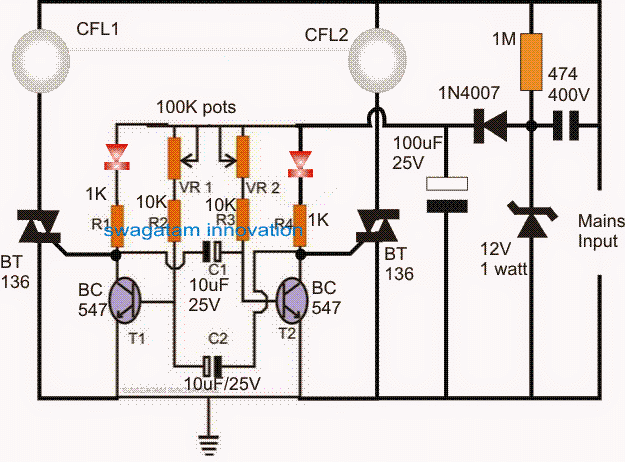This is a mains operated transformerless flasher circuit that can be used for alternately switching a couple of CFL or similar 220V/120V lamp to produce a decorative lighting effect.
Circuit Operation
The below shown design depicts a simple mains operated dual or alternate lamp flasher, which is designed to flash or blink two mains operated lamps alternately at a specific rate as determined by the 100k pot adjustments.

The circuit stage built around T1 and T2 is an ordinary astable multivibrator wherein the transistors switch alternately at a given rate as set by the values of C1, C2 and /or the values of the pots VR1 and VR2.
VR1 and VR2 can be discretely adjusted to produce different sets of flashing rates for the two lamps, or can be fixed in the middle for generating a uniform flashing pattern for the lamps.
The lamps are switched through the indicated triacs whose switching is controlled by the switching rate of the transistors, during the transistor OFF periods the traics are switched ON and vice versa, this effect is not simultaneous, rather implemented alternately for the traics giving rise to the proposed alternate flashing effect for the lamps.
Power Supply
THE CIRCUIT IS NOT ISOLATED FROM MAINS AC, AND IS THEREFORE EXTREMELY DANGEROUS TO TOUCH IN POWERED CONDITION AND WITHOUT AN INSULATED ENCLOSURE. EXTREME CAUTION IS ADVISED WHILE TESTING OR BUILDING THIS CIRCUIT.
The entire circuit is powered through a simple 12V stabilized transformerless power supply made by using a high voltage capacitor 474/400V, a rectifier diode and a 12V zener diode.
The 100uF capacitor filters the 12V stabilized half rectified output from the 1N4007 output and feeds a clean DC to the rest of the circuit for the intended operations.
Hai I have tried the above cicrcuit but not working I have modified this same circuit using opamp I have designed entire circuit with proper zener current now it is working fine tested if anyone need they can contact in email thank you
Op amp is absolutely not required. The above transistor circuit will 100% work if done correctly with proper understanding.
Thank you so much sir
Hi, i want to know what is the usage of the 2 LEDs, does the circuit still work if I delete them? thx
LEDs are only indication of the flashing action, it is not mandatory to keep the LEDs, you can replace them with a short link.
thanks a lot!
Hi, I made this circuit into PCB, but the 2 lamps light constantly, they do not flash, what could be the possible reason?
Connect the LEDs in the shown position and check whether the LEDs are alternately blinking or not. If they are not blinking alternately then your transistor oscillator has problems and it might not be working correctly due to some fault.
thanks!
sir i want to flash 3 nos ac bulbs just flash as 1,2,3 1,2,3 so on. request instructions please
Hi Jayanth, you can use the following concept
https://www.homemade-circuits.com/make-this-diwali-christmas-running/
use only pin3, 2, 4, for lamp connection and ignore all the rest, and remove pin#15 connection from the ground and connect it with the pin#7
also make sure to use a 50 ohm 1 watt resistor in series with the input capacitor 474/400V
sir please indicate the circuit for simple on off flasher for one ac bulb
Pradeep, you can use the same circuit that's shown above, just eliminate one of the side's triac